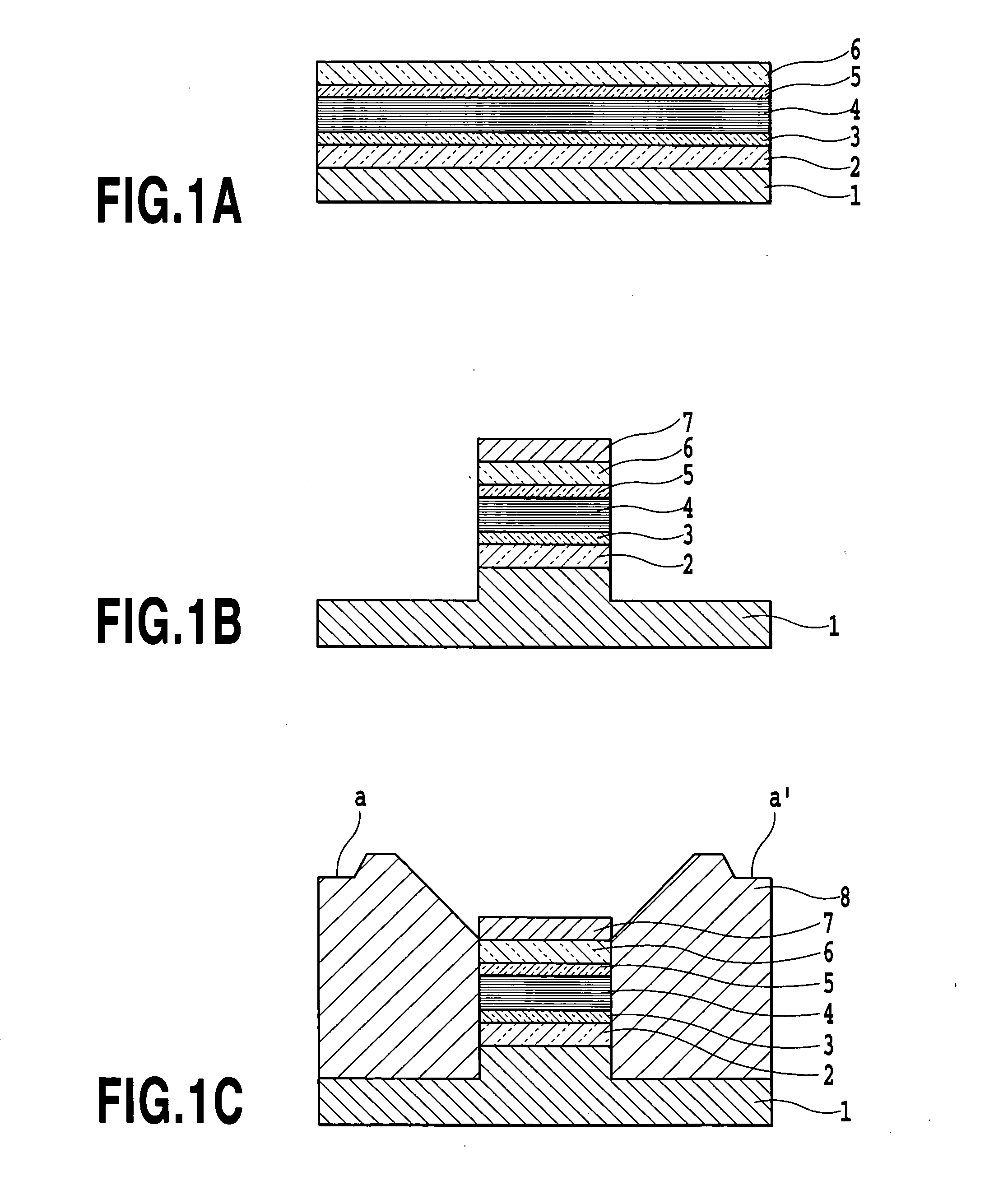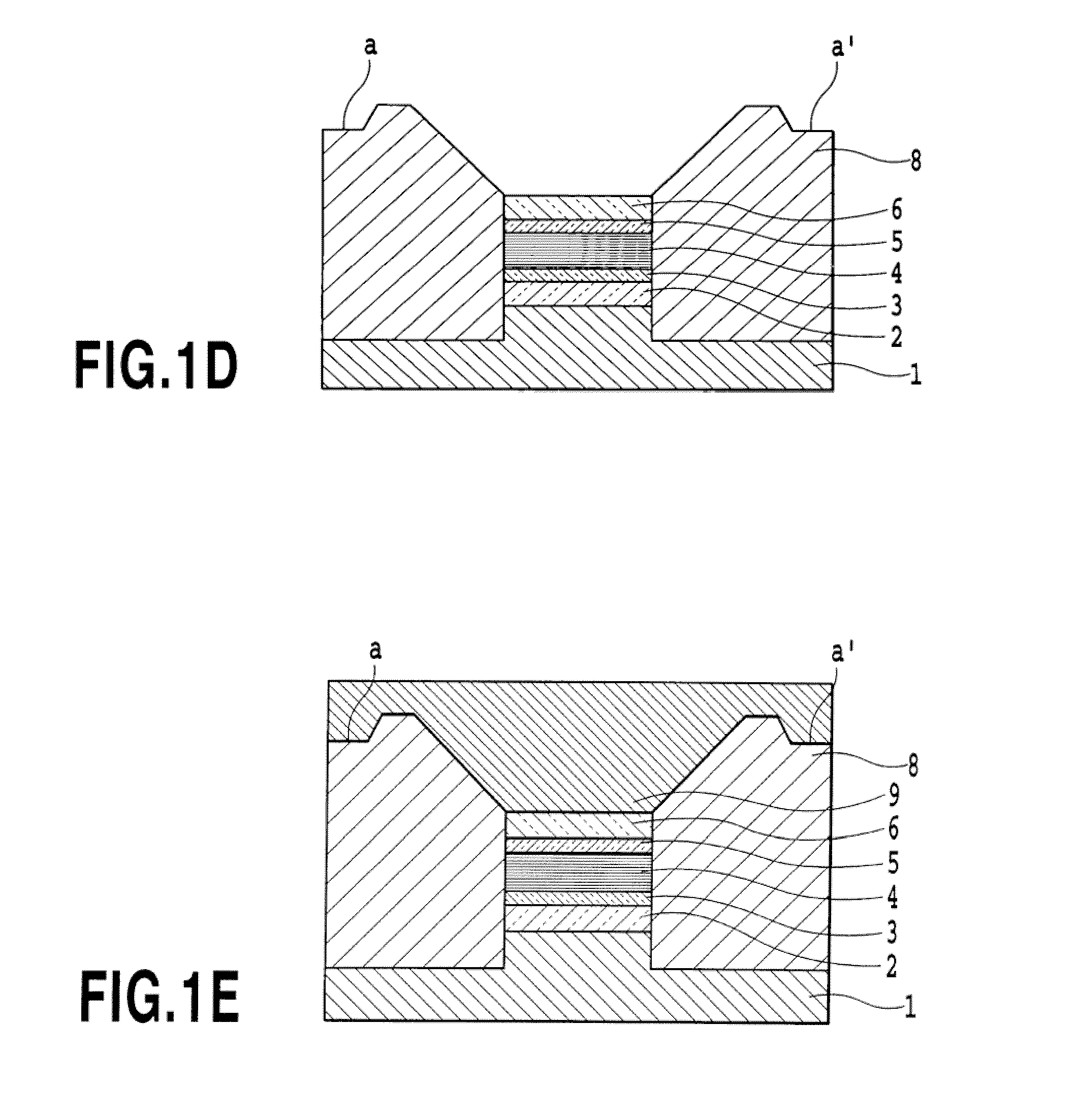Semiconductor Optical Element and Manufacturing Method Thereof
a technology of semiconductor and optical elements, applied in semiconductor devices, lasers, semiconductor lasers, etc., to achieve the effect of enhancing fabrication yield and excellent device characteristics
- Summary
- Abstract
- Description
- Claims
- Application Information
AI Technical Summary
Benefits of technology
Problems solved by technology
Method used
Image
Examples
embodiment 1
[0047]FIGS. 1A to 1G show processes for fabricating a semiconductor device according to a first embodiment of the present invention. These figures are cross sectional views of a directly modulated semiconductor DFB laser using an MQW as an active layer. Firstly, as shown in FIG. 1A, a Zn-doped p-type InP cladding layer 2 having a layer thickness of 0.5 μm, a nondoped-InGaAsP lower separate confinement heterostructure (SCH) layer 3 having a layer thickness of 0.05 μm, a non-doped InGaAsP / InGaAsP strain multiple quantum well (MQW) active layer 4 having a layer thickness of 0.15 μm and having a bandgap wavelength of 1.3 μm, and a non-doped InGaAsP upper separate confinement heterostructure (SCH) layer 5 having a layer thickness of 0.05 μm were grown in order on a Zn-doped p-type InP substrate 1 having surface orientation (100) by utilizing a metal organic vapor-phase epitaxy (MOVPE) method. After a diffraction grating was formed on an upper portion of the InGaAsP upper separate confine...
embodiment 2
[0063]FIGS. 4A to 4G show processes for fabricating a semiconductor device according to a second embodiment of the present invention. These figures are cross sectional views showing a directly modulated semiconductor DFB laser having an MQW as an active layer. Firstly, as shown in FIG. 4A, a Zn-doped n-type InP cladding layer 22 having a layer thickness of 0.5 μm, a nondoped-InGaAsP lower separate confinement heterostructure (SCH) layer 23 having a layer thickness of 0.05 μm, a nondoped-InGaAsP / InGaAsP strain multiple quantum well (MQW) active layer 24 having a layer thickness of 0.15 μm and having a bandgap wavelength of 1.3 μm, and a nondoped-InGaAsP upper separate confinement heterostructure (SCH) layer 25 having a layer thickness of 0.05 μm were grown in order on a Zn-doped p-type InP substrate 21 having surface orientation (100) by utilizing the metal organic vapor-phase epitaxy (MOVPE) method. After a diffraction grating was formed on an upper portion of the InGaAsP upper sepa...
embodiment 3
[0069]FIGS. 5A to 5G show processes for fabricating a semiconductor device according to a third embodiment of the present invention. These figures are cross sectional views of a directly modulated semiconductor DFB laser having an MQW as an active layer. Firstly, as shown in FIG. 5A, a Zn-doped p-type InP cladding layer 42 having a layer thickness of 0.5 μm, a nondoped-InGaAsP lower separate confinement heterostructure (SCH) layer 43 having a layer thickness of 0.05 μm, a nondoped-InGaAsP / InGaAsP strain multiple quantum well (MQW) active layer 44 having a layer thickness of 0.15 μm and having a bandgap wavelength of 1.3 μm, and a nondoped-InGaAsP upper separate confinement heterostructure (SCH) layer 45 having a layer thickness of 0.05 μm were successively grown on a Zn-doped p-type InP substrate 41 having surface orientation (100) by utilizing the metal organic vapor-phase epitaxy (MOVPE) method. After a diffraction grating was formed on an upper portion of the InGaAsP upper separa...
PUM
 Login to View More
Login to View More Abstract
Description
Claims
Application Information
 Login to View More
Login to View More - R&D
- Intellectual Property
- Life Sciences
- Materials
- Tech Scout
- Unparalleled Data Quality
- Higher Quality Content
- 60% Fewer Hallucinations
Browse by: Latest US Patents, China's latest patents, Technical Efficacy Thesaurus, Application Domain, Technology Topic, Popular Technical Reports.
© 2025 PatSnap. All rights reserved.Legal|Privacy policy|Modern Slavery Act Transparency Statement|Sitemap|About US| Contact US: help@patsnap.com



